Like their relatives in the Felidae family, wild cats, especially rare species, seem to be more closely connected to humans. Most of them live on land but are excellent swimmers and exhibit many behaviors that no other animal possesses. Notably, despite being domesticated as friendly pets, there are still 11 species of wild cats classified as critically endangered, rare, and protected worldwide.
The Rarest Wild Cat Species on Earth
- 1. African Golden Cat (Caracal caracal) – A widely distributed species with great drought resistance
- 2. Black-footed Cat (Felis nigripes) – The smallest and least populous species, yet polygamous
- 3. Geoffroy’s Cat (Leopardus geoffroyi) – A species that prefers varied habitats
- 4. Andean Mountain Cat (Leopardus jacobita) – The species with the longest tail, living at the highest altitudes
- 5. Southern Tiger Cat (Leopardus tigrinus) – The smallest cat species in the world
- 6. Margay Cat (Leopardus wiedii) – A species known for its climbing ability
- 7. Iberian Lynx (Lynx pardinus) – The species with the narrowest natural distribution in the world
- 8. Marbled Cat (Pardofelis marmorata) – The cat with the longest tail
- 9. Bengal Cat (Prionailurus bengalensis) – The cat with the widest natural distribution across Asia
- 10. Flat-headed Cat (Prionailurus planiceps) – A cat capable of swimming and diving
- 11. Rusty-spotted Cat (Prionailurus rubiginosus) – The species with the narrowest distribution and the smallest size
1. African Golden Cat (Caracal caracal) – A widely distributed species with great drought resistance
This is the most widely distributed cat species in the world, found in the wild across 60 countries in Asia and Africa. The populations in Asia are listed under CITES Appendix I, prohibiting international trade for commercial purposes. The populations in Africa fall under CITES Appendix II.
Among the Felidae family, the African Golden Cat is a medium-sized species that is often favored as a pet. They have a sturdy build, long legs, short faces, tufted ears, and long canines. Their fur is reddish-brown or sandy, with a lighter-colored belly featuring small reddish patches. The body length reaches 40–50 cm and weighs between 8–19 kg.
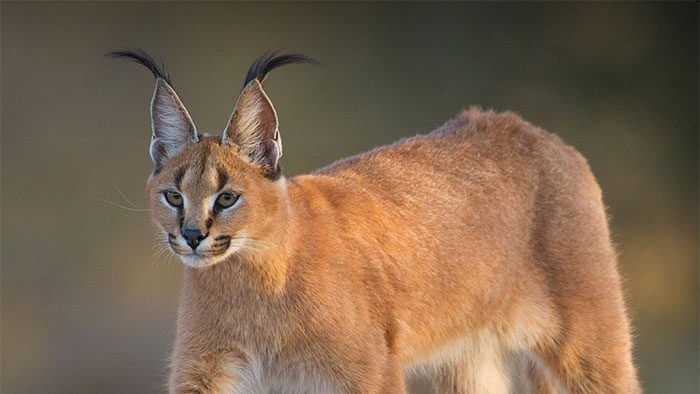
African Golden Cat (Caracal caracal). (Photo: San Diego Zoo).
They have a distinctive narrow black stripe running from the eye to the nose, extending down the middle of the forehead, with brown-yellow eyes having round pupils instead of slits. Juveniles have reddish spots on their undersides that adults lack.
African Golden Cats prefer to live in forests, woodlands, savannas, grasslands, semi-deserts, and scrub forests, particularly favoring arid areas with low rainfall and ample cover. They can also be found in mountainous habitats like the Ethiopian Highlands.
Being strictly carnivorous, their primary prey includes antelope, wild rabbits, rodents, small monkeys, and birds. African Golden Cats can survive without drinking water by obtaining moisture from their prey. Climate, area, and sex influence the range size of individuals, with males typically having a range twice that of females. The size of home ranges is also affected by water availability.
In arid regions, much larger home ranges are maintained. In parts of Africa, a male’s territory can range from 31 to 65 km², while females in the same area maintain ranges of 4 to 31 km².
In parts of Asia, males usually maintain territorial ranges from 200 km² to over 300 km². There are differences in territorial exclusivity based on sex. A male’s territory may overlap with that of several other males, while a female defends her entire territory for personal use.
This species is polygamous, with two or more males mating with two or more females. They can mate at any time of the year, but most often between August and December. The gestation period is 10 to 11 weeks, and litters usually consist of three young. African Golden Cats can live over 20 years in captivity, and individuals from African populations are highly valued as pets.
2. Black-footed Cat (Felis nigripes) – The smallest and least populous species, yet polygamous
The Black-footed Cat is also listed under CITES Appendix I and is found only in the southern African grasslands and savannas (Botswana, Namibia, South Africa, Angola, Zimbabwe, and Lesotho). The terrain where they live receives an average rainfall of 100 to 500 mm per year. They create dens in abandoned burrows or termite mounds and also take temporary shelter in dense bushes.
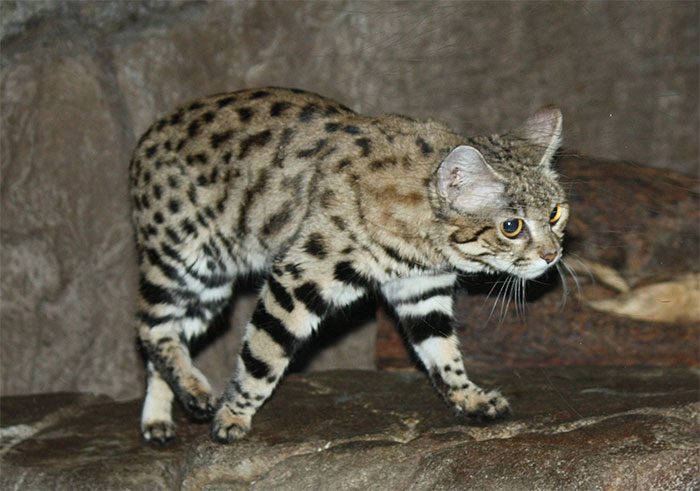
Black-footed Cat (Felis nigripes). (Photo: iNaturalist).
The Black-footed Cat is the smallest of the African species. Its body is covered with light brown fur with dark to deep brown spots covering its back, sides, and belly. Dark brown stripes similar to the spots appear on the cheeks, forelegs, hips, and tail.
Additionally, the tip of the tail is solid black (about twice as thick as the stripes around the tail). The tail averages 150 to 200 mm in length, about half the body length. The undersides of the paws, often visible due to their digitigrade walking style, are black, which gives rise to their common name. Males are slightly larger than females, averaging 1.93 kg compared to 1.3 kg for females. The Black-footed Cat exhibits polygamous behavior, as a male’s territory can overlap with up to five female ranges, while a female’s range typically overlaps with only one male’s territory.
Before mating, females increase their urine marking to advertise their readiness to local males. Copulation is the only time Black-footed Cats are seen together, apart from females with their kittens. Males and females only come together for 5 to 10 hours to mate.
This species also has a relatively long lifespan, reaching up to 15.6 years in captivity. The diet of the Black-footed Cat is quite diverse: 98% consists of mammals and birds, with mammals accounting for 72% and birds for 26% of their diet. Animals weighing less than 40 g make up more than half of their prey.
Larger animals are primarily hunted during winter when smaller prey is scarce. These larger animals can be stored for later use. The remaining 2% of prey includes small amphibians, reptiles, and invertebrates. The population of Black-footed Cats is declining due to habitat degradation, threats from hunters, and poison bait intended for other predatory species.
The population of Black-footed Cats is decreasing, with an estimated 9,700 individuals remaining in the wild.
3. Geoffroy’s Cat (Leopardus geoffroyi) – A species that prefers varied habitats
This species is native to South America (Argentina, Brazil, Bolivia, Chile, Paraguay, Uruguay) and inhabits many tropical and subtropical terrestrial ecosystems. These habitats include dry mountain grasslands and shrublands, coastal wetlands, savannas and marshes, temperate grasslands, prairies, and deciduous forests. The habitats can be moist or dry with varying plant densities but still provide sufficient cover for Geoffroy’s Cat to hunt effectively.
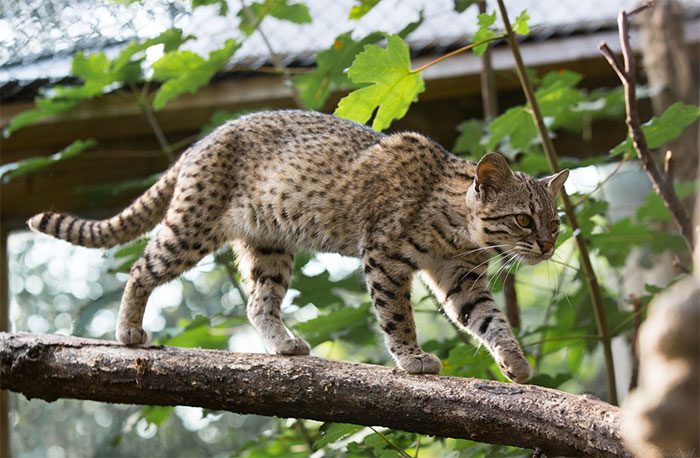
Geoffroy’s Cat (Leopardus geoffroyi). (Photo: iNaturalist).
Geoffroy’s Cats exhibit some flexibility in habitat selection and will move between established national parks and adjacent farmland. Movement between these locations is often driven by the avoidance of predators and to take advantage of high rodent populations in agricultural areas.
Geoffroy’s Cats have dark fur and distinctive circular or elliptical spots, measuring between 15 to 20 mm in diameter. On their backs, the spots are arranged almost in vertical rows. Sometimes, these spots can cluster together, especially along the spine, creating an illusion of black stripes. The base color is smoky gray to yellowish-brown surrounding the spots on their backs.
On the belly, the spots are surrounded by a cream to white undercoat. Geoffroy’s Cats can also exhibit melanistic fur. They are small-sized cats and show sexual dimorphism, with males being larger than females.
The average weight of Geoffroy’s Cats is around 4.3 kg. The head-to-body length ranges from 498 to 750 mm for males and 390 to 515 mm for females.
The tail of Geoffroy’s Cats is relatively long compared to their body length, measuring 300 to 410 mm for males and 265 to 275 mm for females. The length of their hind paws ranges from 115 to 150 mm for males and 110 to 216 mm for females.
This species has very round ears, measuring 45 to 62 mm in length for males and 47 to 57 mm for females.
Geoffroy’s Cats are carnivorous. Within their range, they primarily hunt small mammals, birds, snakes, insects, amphibians, and fish. In southern Brazil, Geoffroy’s Cats hunt Brazilian marsh rats and various terrestrial rodents.
The prey switching can occur between seasons and may lead to the narrowing or expanding of their food niches. The Southern South American wildcat is also a species that is protected at the highest level – CITES Appendix I.
4. Andean Mountain Cat (Leopardus jacobita) – The Cat with the Longest Tail, Living at the Highest Altitudes
Along with the Southern South American wildcat, the Andean mountain cat is only found in South America (Argentina, Bolivia, Chile, Peru). The Andean mountain cat has a grayish coat, with a head, face, and round ears in gray. Its nose and lips are black with white surrounding areas; two dark brown stripes run from the corners of its eyes across the cheeks. There are some black spots on its front legs, yellow-brown spots on its flanks, and up to two narrow, dark rings on its hind legs.
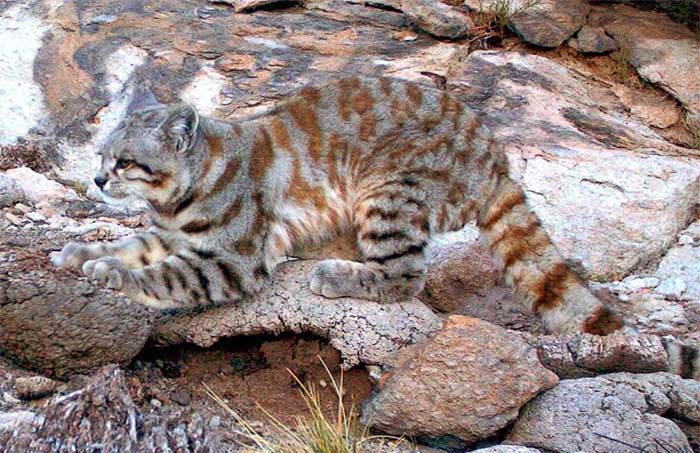
Andean Mountain Cat (Leopardus jacobita). (Photo: Alianza Gato Andino / AGA).
Adult individuals measure from 57.7 to 85 cm in length from head to body with tails ranging from 41.3 to 48.5 cm, a shoulder height of about 36 cm, and weighing up to 5.5 kg.
The Andean mountain cat only lives at high elevations in the Andes: from 1,800 m in the southern Andes to over 4,000 m in Chile, Bolivia, and central Peru. This terrain is arid, with sparse vegetation, rocky, and sloped, indicating that the Andean mountain cat prefers temperate, terrestrial habitats.
With a population of fewer than 1,500 individuals in the wild and a declining population, the Andean mountain cat is listed in CITES Appendix I.
5. Southern Tiger Cat (Leopardus tigrinus) – The Smallest Cat Species in the World
As a species listed in CITES Appendix I, the Southern tiger cat is distributed throughout Brazil and the Guianas (i.e., Guyana, French Guiana, Suriname) and in some regions of Venezuela, Colombia, Ecuador, Bolivia, and Paraguay. This species inhabits elevations from sea level to 3,200 m. They prefer forest habitats and can be found in various forest ecosystems, including dense tropical forests at elevations from sea level to 1,500 m.
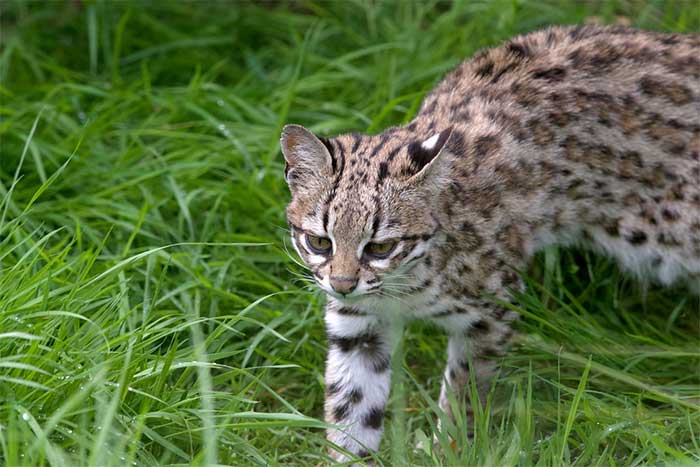
Southern Tiger Cat (Leopardus tigrinus). (Photo: Roger Wasley/Flickr)
The Southern tiger cat weighs between 1.5 kg and 3 kg. Males are slightly larger than females and can weigh up to 3 kg, while females usually weigh from 1.5 to 2.0 kg. The male’s head and body length range from 805 to 830 mm, with a tail length of 317 to 360 mm. Females measure from 763 to 780 mm in length, with tails from 270 to 305 mm long.
The Southern tiger cat has short, dense fur that ranges from light brown to gray, adorned with dark brown rosette spots outlined in black. The ventral area is often lighter than the rest of the body but still marked with rosettes. The tail has between 7 to 13 dark rings and ends with a dark tip. The limbs are covered with randomly arranged black spots, and the back of the ears is black with a white spot near the ear center. The eyes can range from light to dark brown.
Southern tiger cats typically live for 10 to 14 years in the wild and can reach up to 23 years in captivity. Their main prey includes birds and small mammals, such as rodents. The population of Southern tiger cats is estimated to be around 10,000 individuals and is declining. Thus, they are protected at the highest level (CITES Appendix I).
6. Margay Cat (Leopardus wiedii) – The Cat with Excellent Climbing Abilities
The margay cat is native to the tropical and subtropical forests of Central and South America. Margays weigh between 2.6 and 4 kg, with body lengths ranging from 48 to 79 cm and tail lengths from 33 to 51 cm.
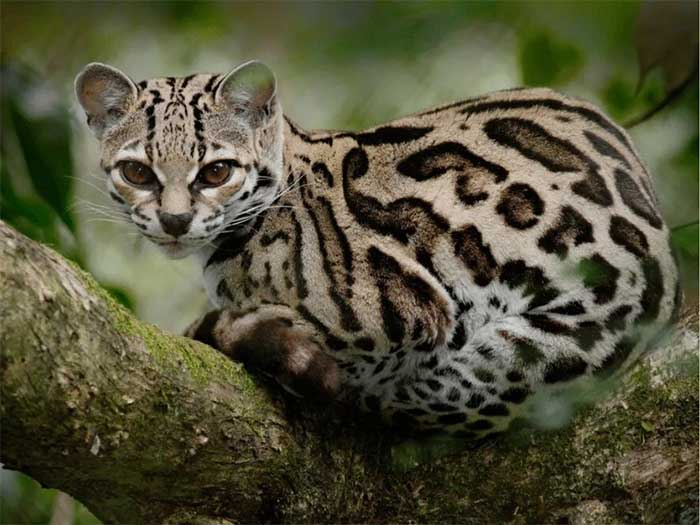 Margay Cat. (Photo: critterfacts).
Margay Cat. (Photo: critterfacts).
Unlike most other cats, female margays have only two nipples. Their brown fur is marked with numerous dark brown or black spots and vertical stripes. The belly is lighter, ranging from a cowhide color to white, and the tail has many dark stripes with a black tip.
The back of their ears is black with round white spots in the center. Margays consume a wide variety of prey, including terrestrial and arboreal mammals, birds and their eggs, amphibians, reptiles, arthropods, and fruits.
Margay cats are noteworthy for their climbing abilities and temperament. They can reverse with their hind legs and dangle by their hind legs when leaping down like a squirrel.
Active both day and night, margays exhibit social behavior, forming temporary pair bonds during the breeding season and achieving relatively long lifespans (20 years) in captivity.
Margays are threatened by commercial hunting for their fur, habitat destruction, and fragmentation. While exact population figures of margays in the wild are not available, recent studies indicate a significant decline. Margays are listed in CITES Appendix I.
7. Iberian Lynx (Lynx pardinus) – The Narrowest Distribution of Any Species in the World
The Iberian lynx is one of two carnivore species native to Europe (the other being the European wildcat). The Iberian lynx is distributed across the Iberian Peninsula, primarily in the southwestern region of Spain and much of Portugal.
Although it once roamed across Europe, the range of the Iberian lynx has alarmingly shrunk over the past century and a half. A century ago, this species was still present in northern Iberia and maintained a relatively high density in the south.
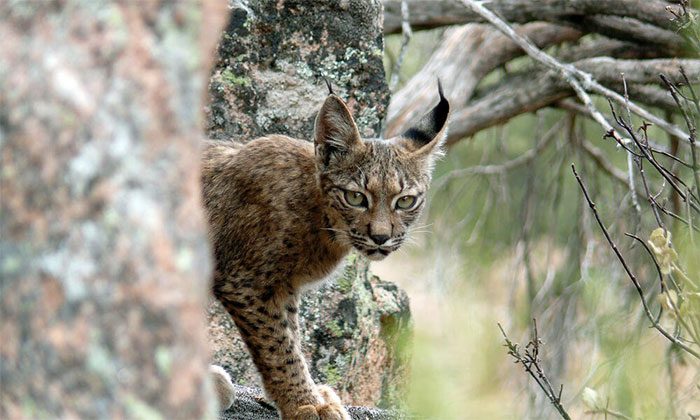
Iberian lynx is the world’s most endangered cat species. (Photo: WWF).
In the last 50 years, they have nearly gone extinct in the north and are rapidly declining in the south. The most significant decline occurred from 1960 to 1990, during which their range shrank by nearly 80%.
There are approximately 880 to 1,150 adult Iberian lynxes, and by 2008, the population had rapidly declined to around 475 to 680 adults, mostly concentrated in Donana National Park (1,500 km²), where they are strictly protected at an elevation of just 50 m above sea level. Although they were once found in Portugal, the Iberian lynx is now believed to be completely extinct in that country.
The Iberian lynx resembles its close relative, the Eurasian lynx, but is only half its size. It has a relatively small head, long legs, and a very short tail with a black tip, which is a common trait of the Lynx species.
They have a flat, short face and tufts of black hair on their ears and jaw, giving them a whiskered appearance, particularly noticeable in adults. Their fur is tawny, dotted with variously sized, shaped, and intensity-patterned black spots.
The oldest wild Iberian lynx recorded was 13 years old at death. It has the highest mortality rate among lynx species (48% annually), with most not reproducing by the time they die. Deaths are often human-caused and include traffic collisions, illegal hunting (5% annually), accidental trapping (6% annually), dog attacks, falling into wells, and wildfires.
Like most felids, the Iberian lynx usually hunts alone and kills prey with a single bite to the neck. Its small size and well-camouflaged coat allow it to adapt well to hunting small mammals.
The main prey of the Iberian lynx is the European rabbit, accounting for 80 to 100% of their daily biomass consumption. An adult Iberian lynx requires between 600 to 1,000 kcal per day, approximately the energy contained in one rabbit. A female with young may need up to three rabbits daily.
The Iberian lynx is considered a professional predator, with its prey preferences showing little geographic or seasonal variation. When European rabbits are scarce, alternative prey includes small vertebrates such as rodents and European hares.
They also prey on birds, including red-legged partridges, ducks, and geese, and are sometimes known to hunt immature ungulates like red deer and wild boar.
Historically, the Iberian lynx was considered a harmful species and was believed to have a significant negative impact on the game industry. Consequently, they were hunted for their fur. However, the decline of the lynx population may harm the small game industry by increasing the incidence of fungal infections and hemorrhagic disease in rabbits, two ailments negatively impacting European rabbits.
It is estimated that there are only about 160 individuals remaining in the wild (critically endangered), and this species is listed in CITES Appendix I.
8. Marbled Cat (Pardofelis marmorata) – The Cat with the Longest Tail
As a species listed in CITES Appendix I, the marbled cat is only found in the wild from the eastern Himalayas to Upper Myanmar and the Indochina region. This distribution includes northern India, Nepal, Sikkim, Assam, Myanmar, Laos, Thailand, Vietnam, Cambodia, the Malay Peninsula, Sumatra, and Borneo.
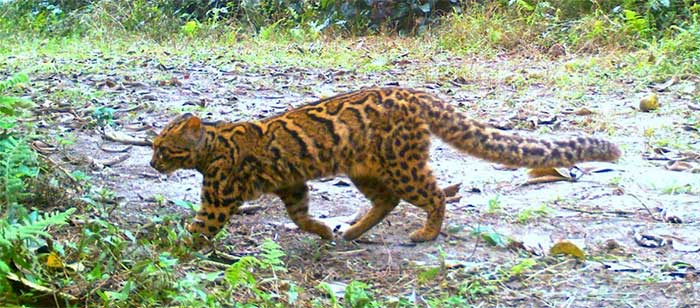
Marbled Cat (Pardofelis marmorata). (Photo: Critter.science).
In the Malaysian region, the marbled cat is only found on the mainland. Their habitats include evergreen, deciduous forests, secondary forests, clearings, six-year-old exploited forests, and rocky shrublands. They can live up to 12 years and 3 months in captivity.
Under captive conditions, the marble cat is known to be docile and is considered easy to domesticate. They are also characterized by their high energy levels, excellent climbing abilities, and remarkable agility. Their front paws have webbing, and their flexible feet feature heel pads that are twice the length of their feet.
They also possess retractable, dual claws, making them very suitable for climbing. Marble cats have a long, bushy tail measuring between 35 to 54 cm (75% of their body length or more), which is ideal for balance.
The primary prey of marble cats includes birds and small arboreal mammals (such as tree squirrels, shrews, rats, mice, small primates, and fruit bats), as well as pheasants, lizards, frogs, and insects.
According to statistics, there are approximately 10,000 marble cats remaining in the wild, and their population is declining due to logging, agricultural activities, and development.
9. Wild Cat (Prionailurus bengalensis) – A Species Widely Distributed Across Asia
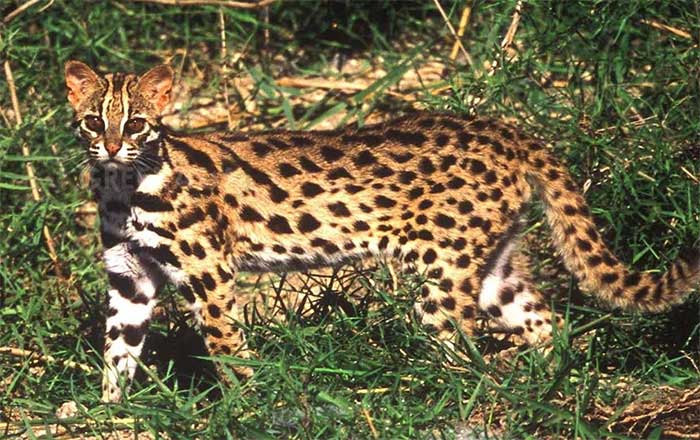
Wild Cat (Prionailurus bengalensis) found in China. (Photo: Plos One).
This is one of the most common carnivorous species in Asia, found in most of South Asia, including Afghanistan and northern Pakistan, India, Myanmar, Laos, Thailand, Indonesia, Malaysia, Vietnam, Taiwan, Sumatra, Java, Bali, Borneo, Nepal, South Korea, Japan, Cambodia, parts of the Philippines, and East China.
The wild cat has the widest distribution among cat species, appearing in tropical and temperate forests, coniferous forests, shrubland, and grassland habitats. Its distribution is limited to areas with less than 10 cm of snow annually, and it is not found in arid or dry climates.
Wild cats have a diverse diet and can find food in most habitats. They appear unaffected by human disturbances, as populations are stable in secondary growth and disturbed areas, and they are often found near agricultural fields and rural settlements.
However, a standout characteristic of wild cats is their exceptional swimming ability; they can swim across large rivers, move gracefully, hunt skillfully, and can leap from trees to catch prey (such as rodents, frogs, birds, poultry, fish, and insects).
The lifespan of wild cats can reach up to 20 years in captivity, while individuals in the wild typically live only up to 4 years. Wild cats are similar in size to large domestic cats, averaging between 3 to 7 kg.
Overall, they have a light reddish-brown coat with a white underbelly. Their body and tail are covered with rosettes, and their tails often have rings at the tip. Four vertical stripes run from the forehead down to the neck. Their body length ranges from 44.5 to 107 cm, and their tails measure between 23 to 44 cm.
Wild cats have small heads with short muzzles and round ears. There is variation in fur length and color based on local environmental conditions. In northern latitudes, their fur tends to be longer and lighter, and they are usually heavier.
Their coloration varies depending on habitat: individuals in snowy environments have lighter fur compared to those in dense forest habitats, which tend to have darker brown-colored pelts.
Although the global population of wild cats remains stable, populations in India, Bangladesh, and Thailand are afforded the highest levels of protection (CITES Appendix I). Populations in other countries fall under CITES Appendix II.
10. Flat-headed Cat (Prionailurus planiceps) – A Species with Swimming and Diving Abilities
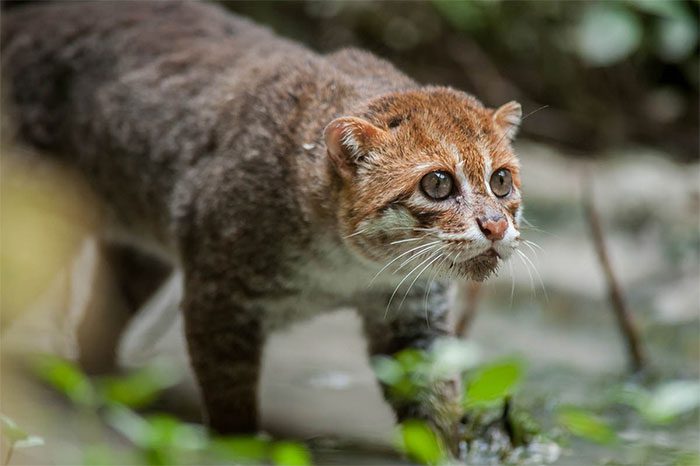
Flat-headed Cat (Prionailurus planiceps). (Photo: Rainforest Action Network).
The flat-headed cat is small, comparable in size to a domestic cat. It has a short tail, measuring only 1/4 to 1/3 the length of its head and body. They have small, round ears that are spaced apart and sit lower than the top of the skull.
They have a long, thick, and soft coat. The fur is reddish-brown on the top of the head, dark brown on the back, and has white spots on the ventral side. Individual hairs have white, brown, or gray tips, giving them a mottled appearance.
Their face is lighter than the body, and their muzzle, chin, and chest are white. Their eyelids and the inner part of each eye are white but do not form a complete eye ring, and there are two dark stripes running along each side of the head, one from the corner of the eye to below the ear and the other from below the ear down the neck. Their heads are distinctly long and flat compared to other cat species.
Flat-headed cats can dive up to 12 cm underwater to catch prey, with their favorite targets being fish, frogs, and rodents. They have an average lifespan of 14 years.
Flat-headed cats are naturally distributed in Brunei Darussalam, Malaysia, Myanmar, Indonesia, Singapore, and Thailand, and their populations are declining (estimated at under 2,500 individuals). As a result, flat-headed cats are protected at the highest level – CITES Appendix I.
11. Rusty-spotted Cat (Prionailurus rubiginosus) – The Smallest and Most Restricted Cat Species
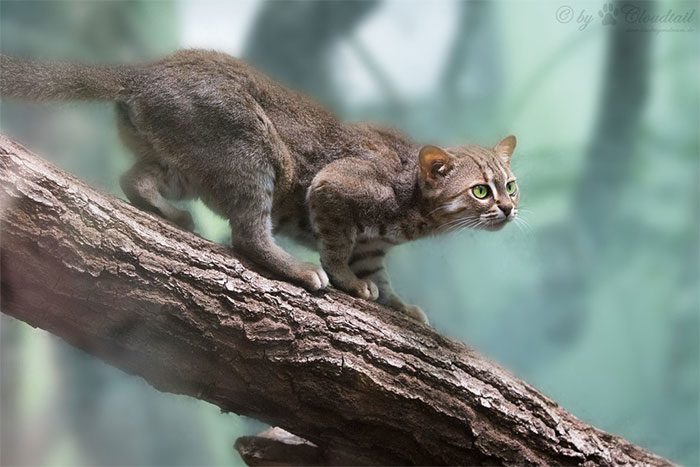
Rusty-spotted Cat (Prionailurus rubiginosus). (Photo: iNaturalist)
The rusty-spotted cat is only found in Sri Lanka, Nepal, Pakistan, and India, in areas of dry forests in semi-arid and tropical climates.
The coat of the rusty-spotted cat is short and dark brown-gray. The underside and throat are white with darker spots and stripes. The back and sides are covered with rusty brown spots. There are four black stripes running from above the eyes, between the ears, and up to the shoulders.
The cheeks are marked by two darker hair stripes, and their ears are small and round. The paw pads are black, and the tail is half the length of the head and body combined.
With a size only half that of a domestic cat, this species is considered the smallest cat. Adult females can weigh up to 1.4 kg, while adult males can reach up to 1.7 kg.
During the first 100 days of development, males are smaller than females, but after that period, males typically weigh more.
They are solitary animals, living alone in the forest and prefer to eat birds, small mammals, and domestic poultry. Notably, despite their small size, rusty-spotted cats can attack similarly sized or larger prey, such as rabbits (in a zoo, a 1.6 kg rusty-spotted cat attacked and killed a 1.77 kg rabbit). The lifespan of rusty-spotted cats can reach up to 18 years.
The population is declining, with an estimated 10,000 individuals remaining, and the rusty-spotted cat population in India is afforded the highest level of protection (CITES Appendix I). Populations in Sri Lanka, Nepal, and Pakistan fall under CITES Appendix II.
|


















































